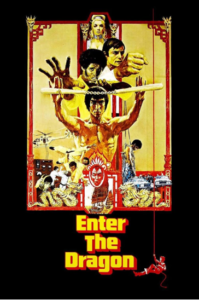
Enter the Dragon (1973)
Directed by Michael Clouse
Starring Bruce Lee, John Saxon, and Jim Kelly
I watched Enter the Dragon last night. And as it opened, I realized that I’d never seen it before. It is such a classic film, referred to so often, that I assumed I’d seen it. But the images I had in my head were from other Bruce Lee films.
I wasn’t sure I was going to get through it, and I was working on my laptop at the same time. But after five minutes, I put that down and had a very pleasant 99 minutes, which – for those with a sense of camp or an interest in film history – I can readily recommend.
It was much better than I expected. For one thing, it has a clever plot.
Bruce Lee, as Hong Kong Shaolin monk/marital artist, is recruited as a secret British spy to track down Han, a Hong Kong crime lord and renegade Shaolin monk who sponsors a martial arts competition on his private island in order to recruit talent for his underground drug operations.
Once in Hong Kong, Lee meets Roper, a martial artist and gambling addict (played by John Saxon and modeled on James Bond), and Williams, an African-American martial artist (played by Jim Kelly in his first film appearance). They are invited, along with others, to participate in Han’s competition. Shortly before they leave for the island, Lee learns that the man responsible for his sister’s death is working as Han’s bodyguard.
On the island, facing seemingly insurmountable odds (before, during, and after the actual competition), Lee, Roper, and Kelly battle their way to various forms of victory through the rest of the movie.
Although this is usually classified as a martial arts film, it is just as much a spy thriller and a spoof of spy thrillers. Han is Doctor Evil, with his lethal troops, his henchman, his training academy, and his drug factory. And like the Bond movies, there are plenty of beautiful and available women and action galore.
There is also an element of the Black/White Buddy genre here, as Roper and Williams turn out to be fellow Vietnam vets, working together much like Robert Culp and Bill Cosby did in the I Spy TV series. (Williams’s character, as expected, does not live till the final act.)
All in all, a terrifically enjoyable film.
Critical Reviews
* Sascha Matuszak of Vice noted that Enter the Dragon “is referenced in all manner of media, the plot line and characters continue to influence storytellers today, and the impact was particularly felt in the revolutionizing way the film portrayed African-Americans, Asians, and traditional martial arts.”
* Joel Stice of Uproxx called it “arguably the most influential Kung Fu movie of all time.”
* In The Inter-Asia Cultural Studies Reader, Kuan-Hsing Chen and Beng Huat Chua cited its fight scenes as being influential for the way they pitched “an elemental story of good against evil in such a spectacle-saturated way.”
Interesting Facts
* Enter the Dragon was Bruce Lee’s final completed film appearance before his death on July 20, 1973 at age 32.
* The film was shot on location in Hong Kong. All the scenes were filmed without sound. Dialogue and sound effects were dubbed in during post-production.
* It went on to gross an estimated $350 million worldwide (equivalent to more than $1 billion today, adjusted for inflation), against a budget of $850,000. Having earned more than 400 times its budget, it is one of the most profitable films of all time, as well as being the most profitable martial arts film.
* In 2004, Enter the Dragon was selected for inclusion in the Library of Congress’s National Film Registry (NFR) – a list of films deemed “culturally, historically, or aesthetically significant.”


